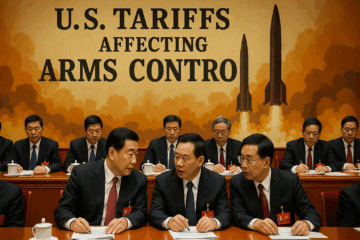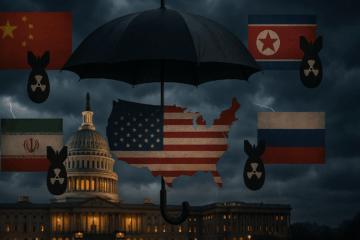Immediately after being sworn in as the nation’s 29th Secretary of Defense, Pete Hegseth established three guiding principles: (1) restore the warrior ethos in everything we do, (2) rebuild the military, and (3) reestablish deterrence. According to Secretary Hegseth, “We don’t want to fight wars; we want to deter them.”
This captures the essence of the doctrine of “peace through strength.” As President Trump described during the commander-in-chief inaugural ball, “We will measure our success not only by the battles we win but also by the wars we end—and perhaps most importantly, the wars we never get into. It’s called peace through strength. Through our power and might, we will lead the world to peace, our friends will respect us, our enemies will fear us, and the whole world will admire the unrivaled greatness of the United States military.”
“Peace through strength” refers to accumulating and displaying forms of national power to create a favorable international environment. The phrase originates from the Roman Emperor Hadrian, who said, “Seek peace through strength, or failing that, peace through threat.” This concept shaped the strategy and goals of Western deterrence during the Cold War and should today. While America squandered its deterrence capabilities, its adversaries relentlessly pursued a deliberate strategy of “subjugation through intimidation.”
The ripening entente between Russia and China, alongside the alarming rate of their expanding and diversifying nuclear arsenals, is further complicated by an expanding North Korean nuclear capability. A collaborative campaign of deliberate and opportunistic aggression fueled by revisionist ambitions torments the South China Sea, is devastating Ukraine, and threatens Taiwan. These malcontent states seek to sow chaos, undermining the existing international order by altering its rules, resource distribution, recognition, territorial boundaries, and economic dominance. To impede these “mavens of malice,” the USA will need to rely on its most formidable hard-power option––nuclear weapons.
Secretary Hegseth must drive the urgent regeneration of America’s nuclear deterrence capability and credibility. This will require an expanded and more capable American nuclear arsenal to effectively counter the mavens’ growing forces. The ongoing $1.1 trillion nuclear enterprise modernization, designed to meet the previous decade’s threat, is plagued by delays in nearly every major system and is insufficient to meet the growing threat of the next decade. The United States requires additional nuclear capacity to ensure deterrence tomorrow. Here are four proposals that President Trump and Secretary Hegseth could initiate tomorrow to enhance the warrior ethos and strengthen deterrence.
First, the United States should suspend participation in New START, as Russia did in February 2023. Regardless of Putin’s grievances, Russia’s actions purposefully undermine the rules-based international order. Given Russia’s consistent history of treaty violations, China’s violation of Article VI of the Nuclear Non-Proliferation Treaty (NPT), and recent revelations Moscow exceeded New START warhead limits in 2024, new arms control treaties are unlikely for the foreseeable future. Moscow perceives military and political advantage by not engaging in these matters, instead pursuing escalation dominance without fear of American reprisal. Participating in any treaty alone devalues the treaty process and demeans American credibility.
Second, the US must immediately cease all warhead dismantlement and begin urgent refurbishment of the remaining 2,000 retired warheads. The provisions of the 2025 National Defense Authorization Act, including salvaging B83 nuclear bombs and W72-2 warheads from retirement, must be implemented immediately. In conjunction with the 2023 decision to build a B61-13, the president should direct the reconditioning and deployment of every weapon in the active and inactive stockpiles to achieve full mission capability as soon as possible.
Third, the president should promptly adjust the posture of America’s current nuclear forces to strengthen deterrence. This includes redeploying stored warheads to re-MIRV the Minuteman III with three warheads per missile—as recently advised by US Strategic Command’s commander, General Anthony Cotton. Adding nearly 800 warheads demonstrates American resolve in the face of China’s and Russia’s nuclear modernization and expansion to reassure allies whose populations contemplate acquiring their own nuclear forces.
Reconfiguring denuclearized bombers to a nuclear-capable configuration and returning bombers to nuclear alert status is critical—with one-fourth of bombers postured for rapid takeoff to ensure survival. Dispersed bombers and supporting tanker aircraft on alert ensure a robust second-strike bomber capability, essential for credible deterrence, preserve employment options for the president, and complicate adversary targeting.
Adversaries cannot believe they can disrupt the crucial detect-decide-direct command and control chain necessary to respond to a nuclear first strike. They must never believe that a decapitating first strike could stop American retaliation. Therefore, alternative and mobile command centers should be continuously enhanced, staffed, and mobilized.
Fourth, rapidly deploying a sea-launched nuclear cruise missile (such as the TLAM-N or SLCM-N) is essential to counter the significant non-strategic nuclear weapons advantage held by both China and Russia. Former Secretary of Defense Casper Weinberger’s report emphasized these systems’ significance over four decades ago. Since 1984, the US regarded nuclear SLCMs on submarines and surface ships as cost-effective and operationally efficient options against a wide range of targets.
Weinberger favored nuclear SLCMs across multiple vessel types to complicate an attacker’s planning and enhance overall survivability of the force. At a minimum, the Navy’s four Ohio-Class guided-missile nuclear submarines could be rearmed with refurbished TLAM-N nuclear cruise missiles that retired from service around 2011. This would enhance the potential at-sea deterrent by 28 percent until the future SLCM-N comes online. Deployment of larger numbers of SLCMs will dramatically increase the size of the survivable sea-based deterrent and provide a viable nuclear-limited strike capability.
Increasing the number of bombers, missiles, and warheads in the active force enhances American military capabilities. Once removed from the constraints of New START, the Ohio-class submarines could be restored to their original capacity of 24 missile tubes, adding 56 submarine-launched (MIRVed) ballistic missiles. B-1 bombers should be retained rather than retired and reconfigured for nuclear operations to meet nuclear and conventional demands on an overburdened bomber force.
With global tensions escalating, the United States must reclaim its position of strength to maintain the peace through a powerful deterrent. Only swift and decisive action can preserve national security and safeguard the global order America forged. The strategic challenges presented by these mavens of malice demand the United States urgently strengthen its nuclear deterrent. Secretary Hegseth inherited a sluggish modernization effort that will not “go faster”––unless it becomes a national priority.
A peace through strength doctrine urgently requires increased capacity and enhanced readiness. Suspending New START participation and returning to a pre-1991 deterrence posture sends a clear message. Any attempt to subvert the global order or threaten American interests will be met with resolute and overwhelming force.
Col. Curtis McGiffin (US Air Force, Ret.) is Vice President for Education of the National Institute for Deterrence Studies and a visiting professor at Missouri State University’s School of Defense and Strategic Studies.
Col. Kirk Fansher (US Air Force, Ret.) is a Senior Fellow at the National Institute for Deterrence Studies, a graduate of the Yale School of Management, and President of Grey Wolf Advisors.







Good comments.
The Problem w our Ohio subs is that they are close to decommissioning. They need to find a way to delay that particulary w Northrop Grummans struggle to build Steam turbines for the new Columbia subs.
Building landmobile Trident D5 missile systems would mitigate that. We should activate all our warheads and add nuclear JASSM, PrSM, Dark Eagle, Prompt Global Strike to our Arsenal to create distributed nuclear deterrence with weapons launchable from multiple platforms. This would reduce our Enemies escalation/ deescalation advantage. Lastly we should add 30 mm canons w computer targeting systems on a large scale to base and ship defense against drones to harden our military infrastructure